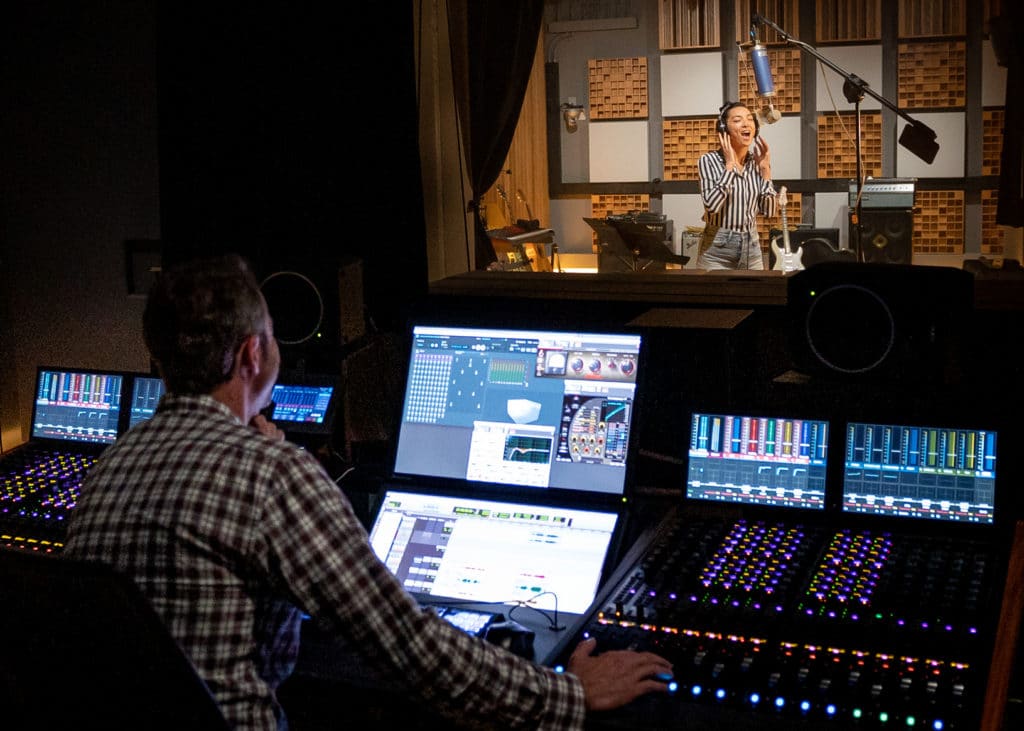This service is perfect for those who have already invested time and resources into creating a stereo mix and want to enhance it with the added dimension of Dolby Atmos. We will work with you to ensure that the Dolby Atmos mastering meets your expectations. The Dolby Mastering will be crafted after you send us the individual stems of your track.
Dolby Atmos is a technology that offers a more immersive and realistic audio experience. It combines traditional channels and “object-based” audio, allowing sound to be placed and moved anywhere in a three-dimensional space.
This results in a more lifelike and dynamic soundstage, with the sound that feels like it is coming from all around you rather than just from the front or rear of the room.
Our service, Dolby Atmos Stem Mastering, takes full advantage of the capabilities of Dolby Atmos. We will place the different mix elements (such as vocals, drums, and instruments) in the 3D sound space. This allows us to create a truly immersive and dynamic audio experience.
One of the critical benefits of Dolby Atmos Stem Mastering is that it allows us to create a more realistic and engaging audio experience for listeners. With traditional surround sound, the sound usually comes from a fixed set of speakers, making it feel like the sound is coming from a specific location in the room.
With Dolby Atmos, we can place sounds anywhere in the 3D sound space, which allows us to create a more dynamic and engaging audio experience.
Dolby Atmos’s technical aspects
Object-Based describes the primary distinction between Dolby Atmos and Channel-Based stereo or surround formats.
Individual DAW tracks are routed to a stereo output bus, two channels, or a surround bus (more than two channels).
Each track’s panner controls which channel the signal goes on. For instance, (L)Left, (R)Right, (C)Centre, (Ls)Left Side, (Rs)Right Side, (Rs)Right Surround (Rear Right), (Ls)Left Surround (Rear Left), (LFE) Low-Frequency Effects.
The mix is committed to a specific channel count, such as stereo, Quad, 5.1, or 7.1, and we require a device with the same number of speakers to play it back. Object-based systems remove this limitation.
Object-Based technology is accompanied by metadata in the file and describes an exact position of a sound in the audio reproduction environment.
After inserts and level, each track’s output is routed straight without pan controls to one of the 128 Dolby Atmos input channels.
The pan control on each track still works; perhaps, instead of routing the audio signal to the output channels, it now generates metadata like GPS data that describes the X, Y, and Z coordinates of where the audio signal is in 3D space.
This metadata will be provided to the Dolby Atmos renderer alongside the audio signal. This track’s signal is an object.
The first 10 of the Dolby Atmos renderer’s 128 input channels are allocated to a conventional channel-based routing system.
On the daw, we can route a track or multiple tracks to a multi-channel bus, such as 7.1.4, utilising the surround paneer. Those ten audio channels are sent to 10 input channels of the Dolby Atmos renderer with pan information contained; It’s called a bed.
Before we begin, we must prepare the Dolby Atmos renderer and assign the 128 renderer channels or the ones we need to an object or a bed, then map and route the individual daw tracks to those objects or bed channels.
They are definite principles for routing a sound or instrument to a bed or object, but lately, it has become a matter of personal preference for the producer.
Channels 1 through 10 can only be allocated to a bed (2.0 up to 10.1.2 ), whereas the remaining 118 channels can be assigned to objects. We can set any of the remaining 118 channels as extra beds, but then they are no longer available for use as objects. Signals that are spatially fixed or that have been pre-recorded in a surround format should be routed to a bed. Sounds we want to locate at exact spatial locations or move around are mapped to objects more effectively. Only tracks routed to a bed in our DAW can be delivered to the LFE. Channel tracks assigned to objects cannot reach the LFE channel without routing methods
Dolby Atmos Render
Dolby Atmos Renderer is the crucial element that differentiates Dolby Atmos from other sound formats with high-speaker channels.
Channel-based formats are set and limited in terms of channel count.
Dolby Atmos is playback agnostic. We create only one Dolby Atmos mix, which can play on systems with any speaker configuration: 7.1.2, 7.1.4, 5.1 stereos, binaural headphones, or any of the Dolby Atmos-compatible smart speakers or sound bars. The idea is simple: up to 128 audio channels and their individual pan information, which means the specific location of those audio signals, are sent into the renderer, which processes that data in real-time to produce a channel-based output. The only information we need to supply the renderer is the channel-based output format we desire, such as 7.1.2, 5.1, binaural headphones, or stereo. Independently of the x, y, or z position a signal has, the renderer attempts to place it on the available speaker in that arrangement. The more speaker channels we have, the more precise the spatial reproduction will be. The fewer channels we have, the less accurate the end result will be. If no height speakers are available, the signals will be routed to the nearest surround speakers. The signals will be incorporated into the stereo mix if no surround speakers are available. The mix we hear at the end may not be immersive or even surround, but we will not lose any signals from the original Dolby Atmos mix.
